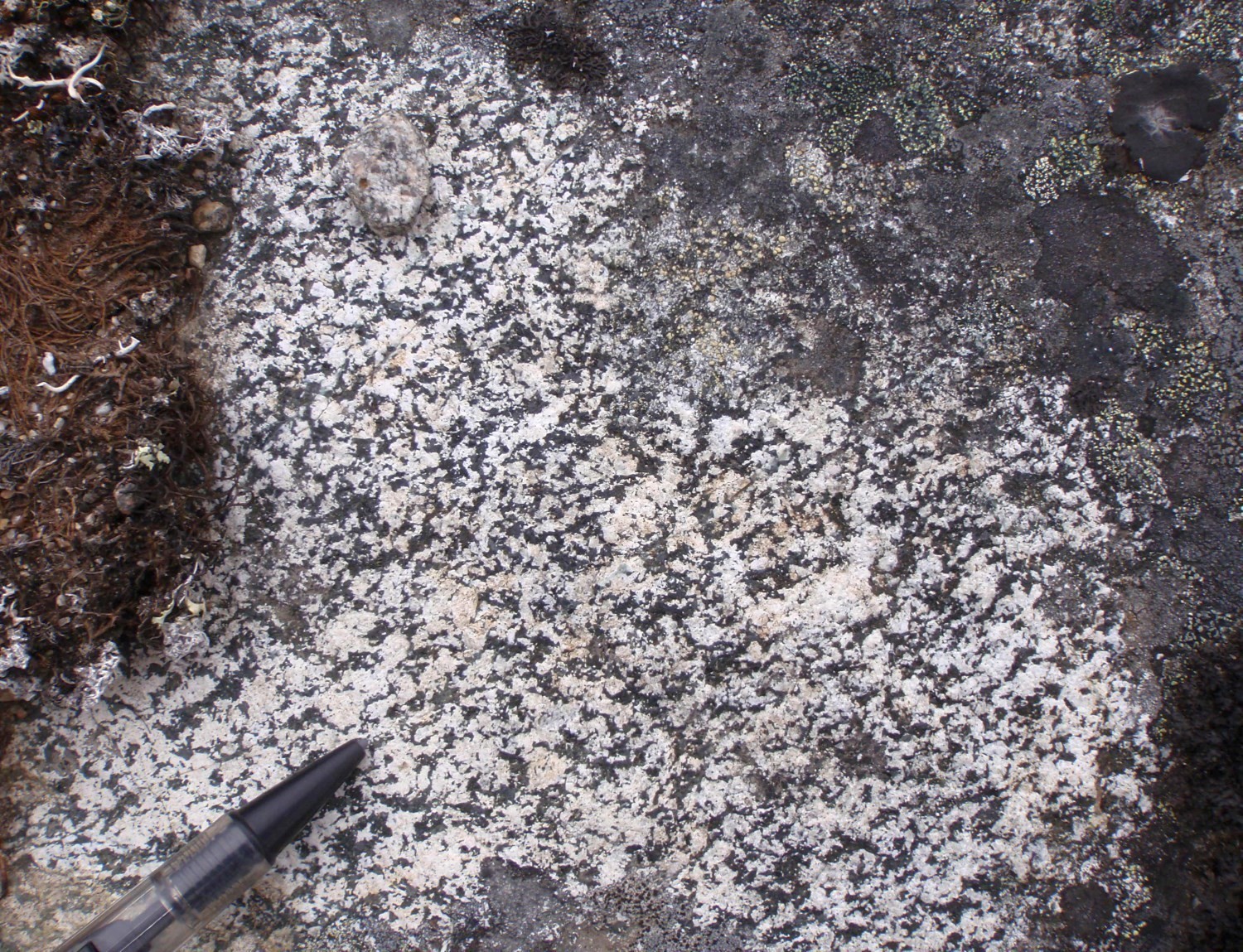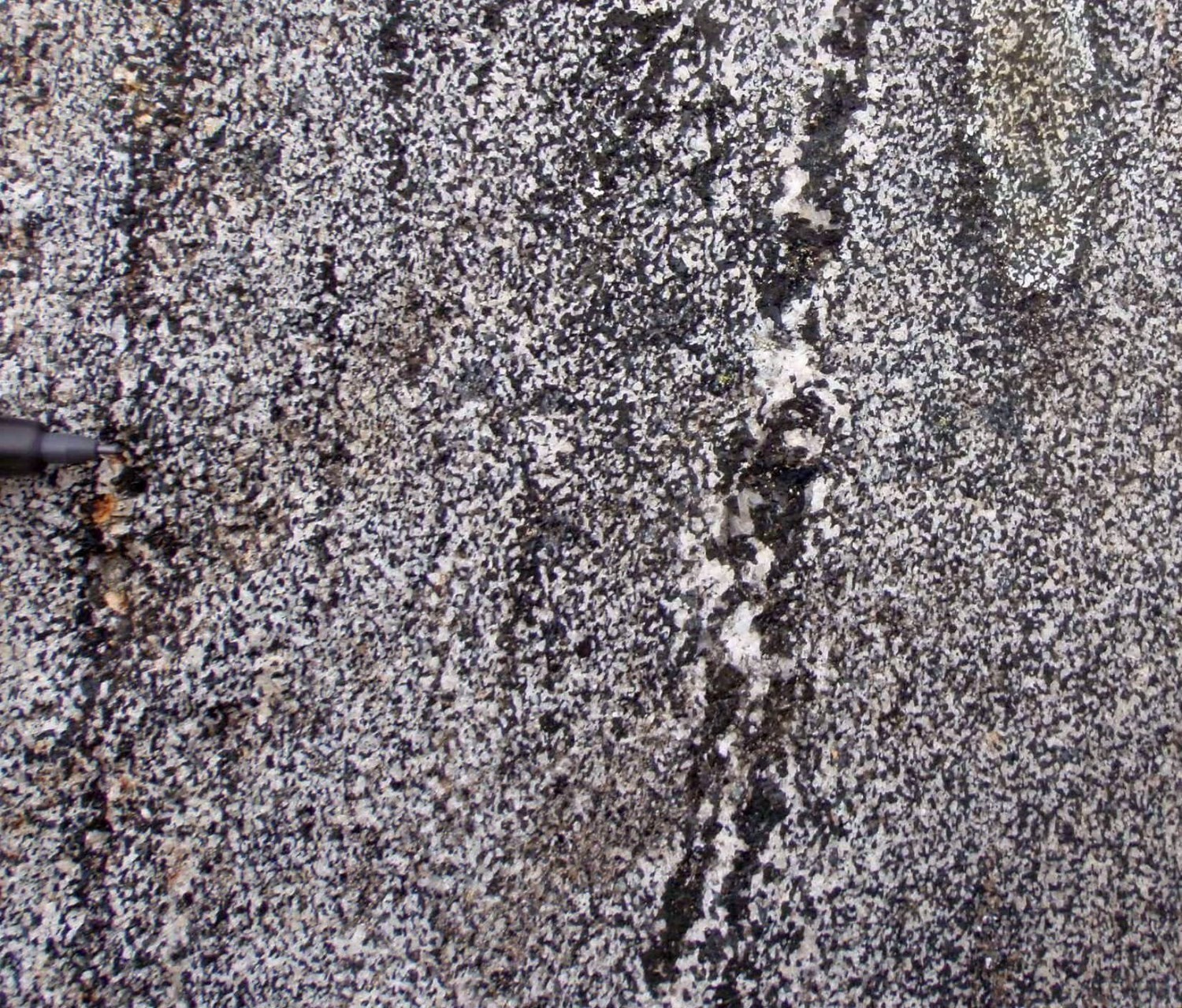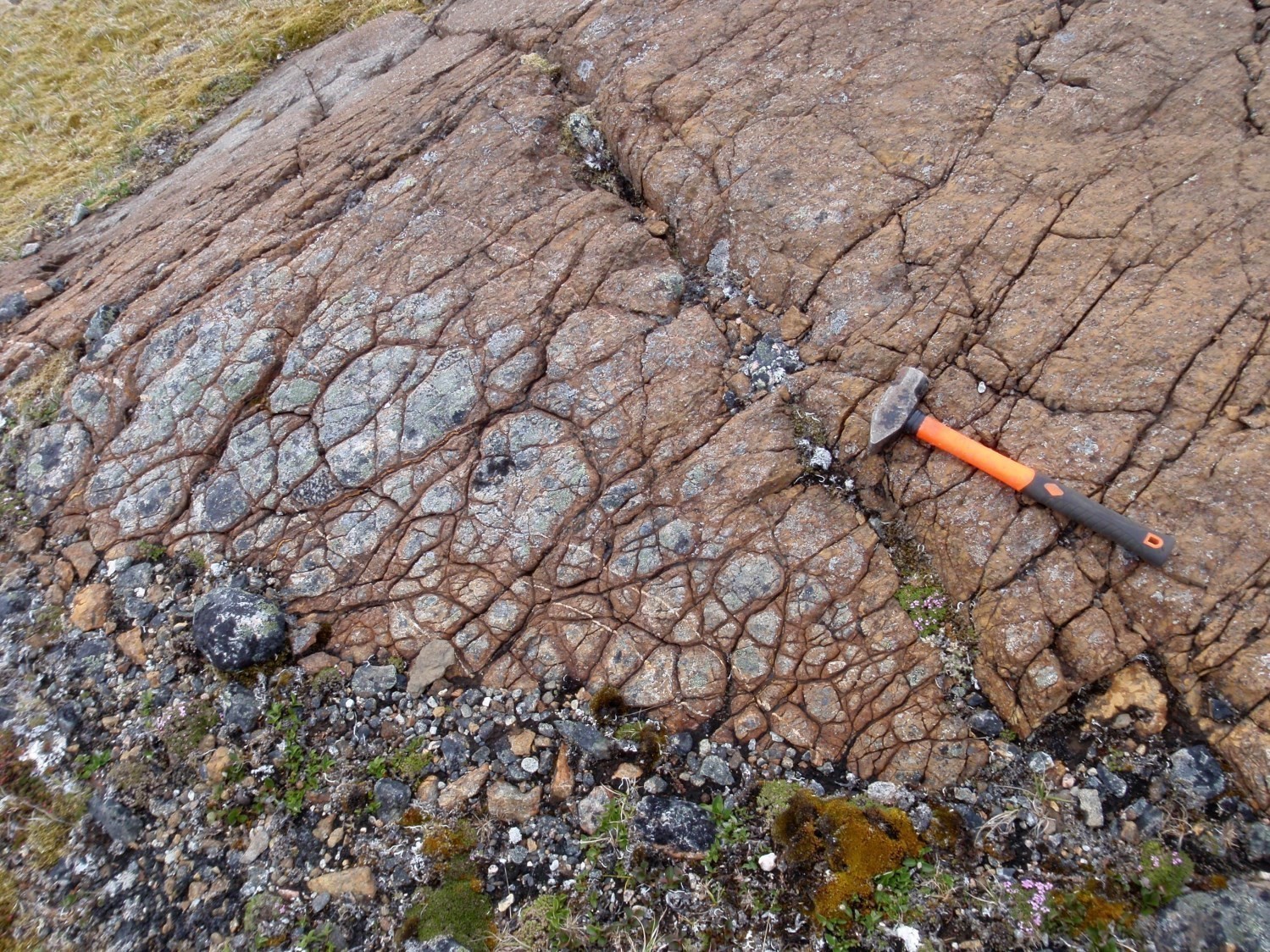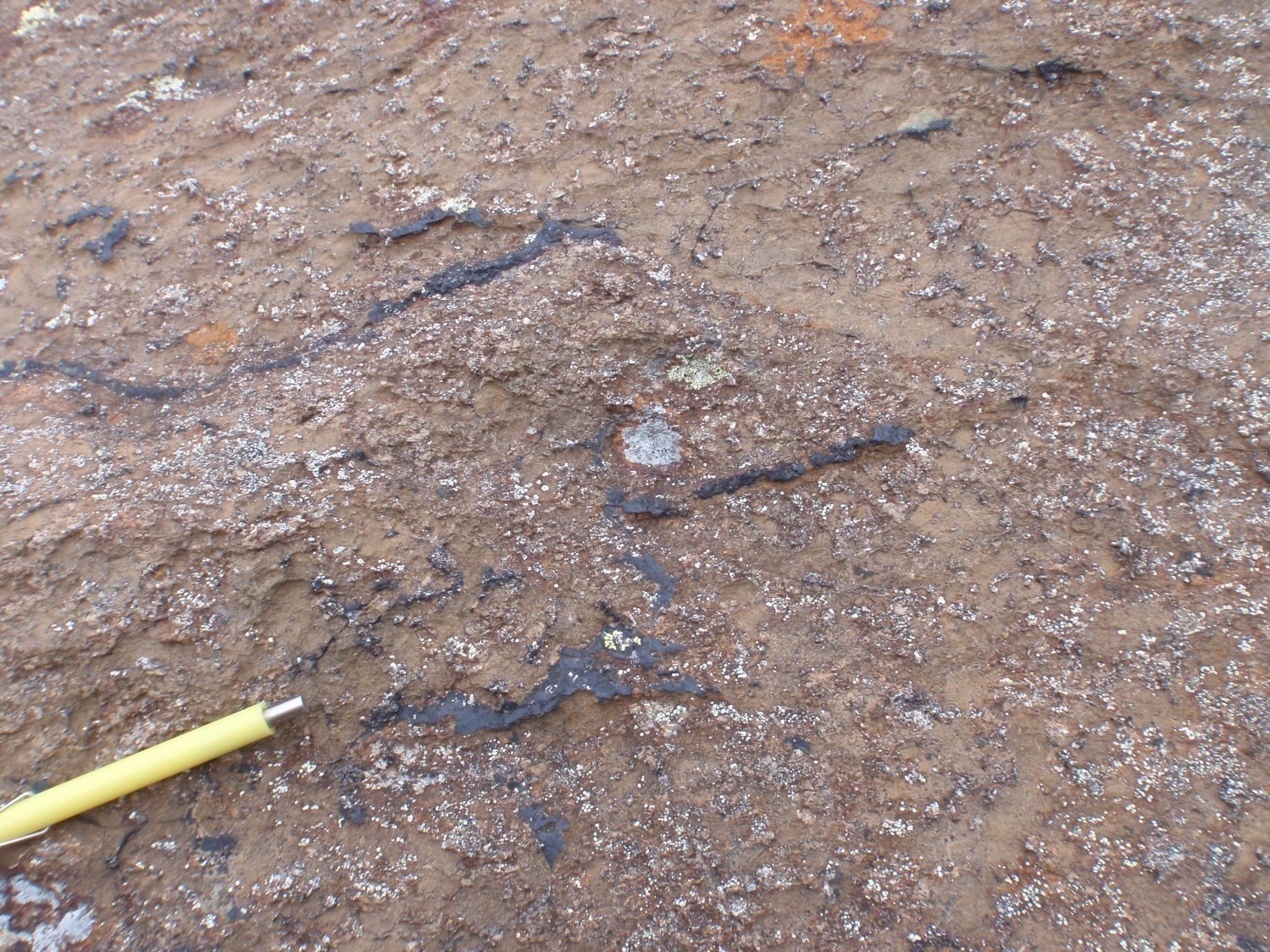
Last modified: 7 October 2022
Translation of original French
| Author(s): | Verpaelst et al., 2000 |
| Age: | Paleoproterozoic |
| Stratotype: | None |
| Type area: | Koroc River area (NTS sheet 24I) |
| Geological province: | Churchill Province |
| Geological subdivision: | Falcoz Lithotectonic Domain |
| Lithology: | Mafic and ultramafic intrusive rocks |
| Category: | Lithodemic |
| Rank: | Suite |
| Status: | Formal |
| Use: | Active |
None
Background
The Nuvulialuk Suite was introduced by Verpaelst et al. (2000) in the Koroc River area (sheet 24I) to group bands of mafic and ultramafic intrusive rocks. It was extended southward in the Henrietta Lake area (Lafrance et al., 2015) and northward in the Pointe Le Droit area (Mathieu et al., 2018). This suite only included rocks located west of the Blumath Shear Zone (ZCblm) at that time. As part of a regional synthesis of the southeastern Churchill Province (SEPC; Lafrance et al., 2018), Lafrance and Vanier (2022) reassigned the mafic and ultramafic rocks previously grouped in the Sukaliuk Complex to the Nuvulialuk Suite. This suite thus includes all mafic and ultramafic intrusive rocks of the Falcoz Lithotectonic Domain. These nomenclature changes are detailed in the table below.
|
Revised Units and Subunits (Lafrance and Vanier, 2022) |
Previous Units and Subunits |
References(s) |
|
pPnuv1 |
pPnuv1 |
Verpaelst et al., 2000; Lafrance et al., 2015 et 2016; Mathieu et al., 2018 |
|
pPnuv1a |
ApPsuk6 |
Lafrance et al., 2015 et 2016 |
|
ApPsuk3a |
Mathieu et al., 2018 |
|
|
pPnuv1b |
ApPsuk6a |
Lafrance et al., 2015 et 2016 |
|
ApPsuk3b |
Mathieu et al., 2018 |
|
|
pPnuv2 |
pPnuv2 |
Verpaelst et al., 2000; Lafrance et al., 2015; Mathieu et al., 2018 |
|
pPnuv2a |
pPnuv2 |
Lafrance et al., 2015 |
|
ApPsuk3d |
Mathieu et al., 2018 |
|
|
ApPsuk4 |
Verpaelst et al., 2000 |
|
|
pPnuv3 |
ApPsuk3c |
Mathieu et al., 2018 |
Description
The Nuvulialuk Suite consists of three units: 1) gabbro and gabbronorite (pPnuv1); 2) ultramafic rocks (pPnuv2); and 3) banded anorthosite and quartz anorthosite (pPnuv3).
Nuvulialuk Suite 1 (pPnuv1): Gabbro, Gabbronorite, Diorite and Norite
Unit pPnuv1 consists of gabbro and gabbronorite as well as lesser amounts of diorite, orthopyroxene diorite and norite. These lithologies are all even grained, medium to fine grained, black-and-white speckled and of massive to foliated appearance. In places, the mafic intrusive rocks have experienced some partial melting evidenced by the presence of neosome in diffuse clusters (migmatite patch). This neosome is coarser grained and more heterogeneous than the paleosome. Plagioclase is granoblastic, locally sericitized and occurs between the coarser ferromagnesian minerals. It locally contains rounded quartz inclusions.
Gabbro and diorite are generally non-magnetic and contain 30 to 65% ferromagnesian minerals, mainly green hornblende and actinolite, usually with clinopyroxene (<25%). Quartz (<5%) and brown biotite are common. The latter typically represents <5% of the mineral phases, however, it may be equivalent to hornblende in some samples. In deformed zones, amphiboles and biotite are aligned in foliation. Locally, clinopyroxene is better preserved and represents the principal ferromagnesian mineral. It then forms large poikilitic crystals partially uralitized or small granoblastic grains. The gabbronorite, orthopyroxene diorite and norite are magnetic and slightly richer in ferromagnesian minerals. They contain, in addition to the ferromagnesian minerals mentioned above, orthopyroxene. Intergrowths between pyroxenes and quartz are observed in thin section.
The main accessory minerals are opaque minerals (2-5%; ilmenite, magnetite ± sulphides), apatite, sphene, epidote, zircon and, more locally, carbonates, allanite, muscovite, tourmaline and garnet. Pyroxene relics are more common in the centre of the intrusions. Near the contacts, where the circulation of fluids has been more pronounced, rocks are completely amphibolitized. In the Keglo Bay area (sheet 24P04), an Fe-Ti oxide-rich decimetric to metric layer was observed in a gabbronorite assigned to the Nuvulialuk Suite.
Nuvulialuk Suite 1a (pPnuv1a): Gabbro and Gabbronorite
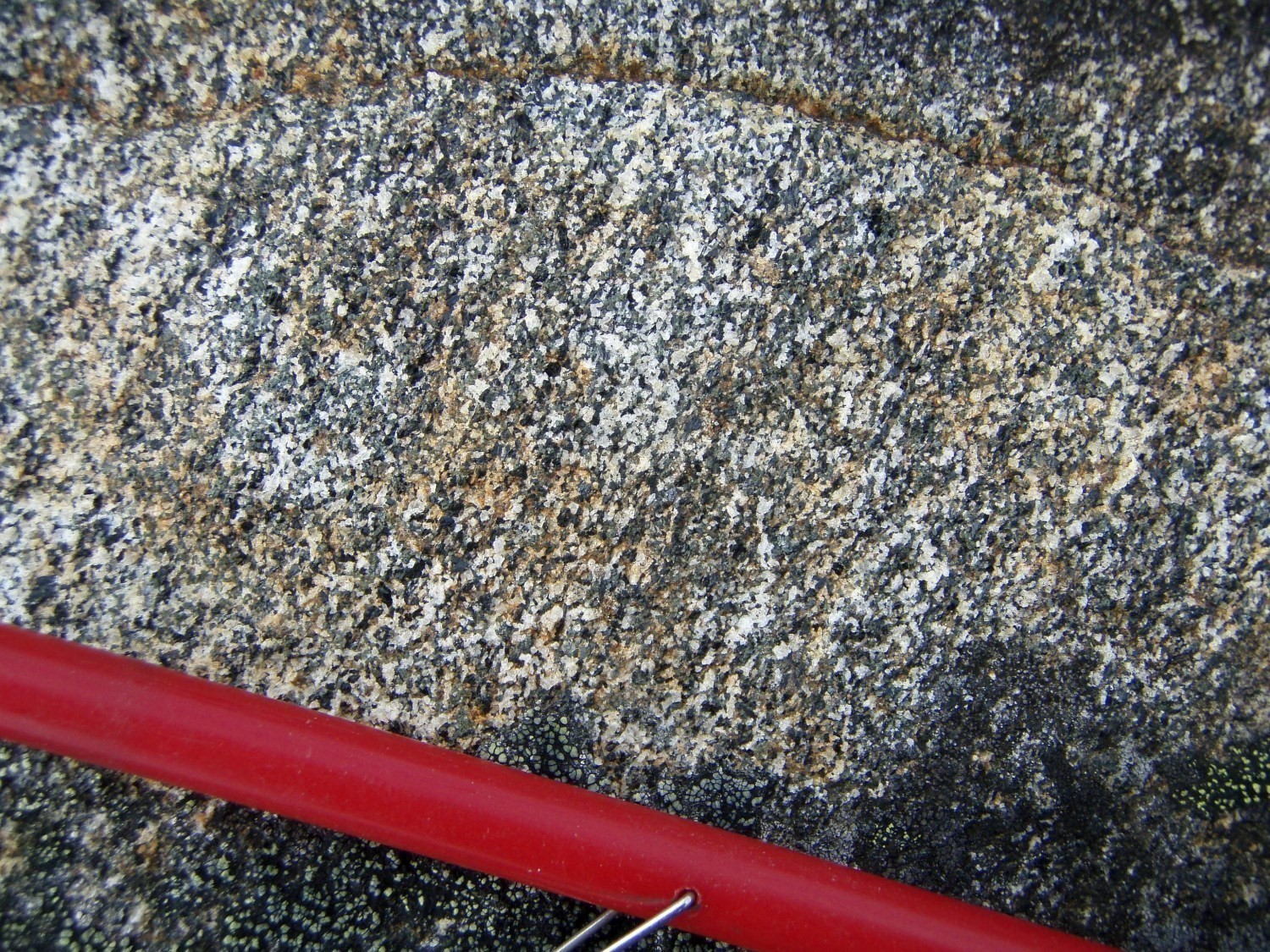 The pPnuv1a subunit comprises gabbro and gabbronorite similar to those of the pPnuv1 unit, but located east of the ZCblm. The fine- to medium-grained rock is homogeneous, equigranular, granoblastic and appears to be little deformed, except near shear zones. It is dark grey to greenish in fresh surface with a salt and pepper alteration patina. Gabbro and gabbronorite contain 25-65% ferromagnesian minerals, mainly green to brown hornblende and clinopyroxene with, more locally, orthopyroxene as porphyroblasts. Biotite, in small brown to red sheets, is generally present, but is only a secondary phase (<5%). Other accessory minerals include opaque minerals (1-5%), quartz (<3%), apatite, zircon, carbonate, and phlogopite. Mafic rocks commonly contain a diffuse, coarse-grained leucocratic phase (<10%) that forms discontinuous millimetre to centimetre clusters and bands within the rock, as well as orthopyroxene porphyroblasts.
The pPnuv1a subunit comprises gabbro and gabbronorite similar to those of the pPnuv1 unit, but located east of the ZCblm. The fine- to medium-grained rock is homogeneous, equigranular, granoblastic and appears to be little deformed, except near shear zones. It is dark grey to greenish in fresh surface with a salt and pepper alteration patina. Gabbro and gabbronorite contain 25-65% ferromagnesian minerals, mainly green to brown hornblende and clinopyroxene with, more locally, orthopyroxene as porphyroblasts. Biotite, in small brown to red sheets, is generally present, but is only a secondary phase (<5%). Other accessory minerals include opaque minerals (1-5%), quartz (<3%), apatite, zircon, carbonate, and phlogopite. Mafic rocks commonly contain a diffuse, coarse-grained leucocratic phase (<10%) that forms discontinuous millimetre to centimetre clusters and bands within the rock, as well as orthopyroxene porphyroblasts.
Nuvulialuk Suite 1b (pPnuv1b): Banded Garnet-Bearing Gabbro and Gabbronorite
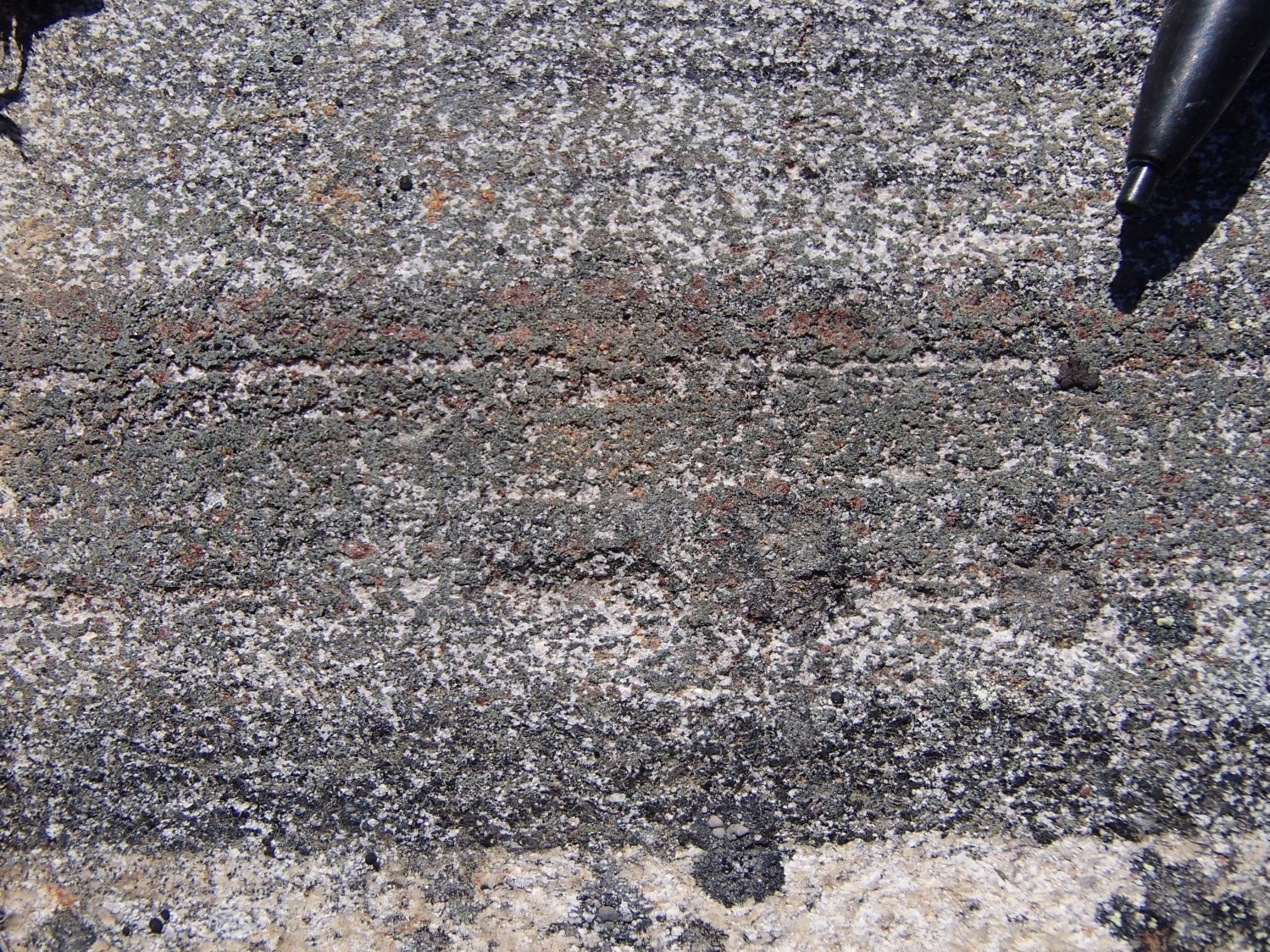 Mafic rocks containing a high proportion of garnet have been grouped into the pPnuv1b subunit. Decimetric to decametric layers have also been observed within the Lake Harbour Suite paragneiss unit, but could not be mapped at the 1:250 000 scale. Garnet generally accounts for 10-25% of the rock and occurs as porphyroblasts (3-8 mm). Centimetric to metric layers and ribbons with >50% garnet are also common. In addition to garnet, the rock contains the same minerals as those in unit pPnuv1a. However, it is generally banded, richer in ferromagnesian minerals, and has the appearance of a gneiss. This banded structure and the spatial association of this subunit with the Lake Harbour Suite make it impossible to exclude that it is, in whole or in part, of supracrustal origin.
Mafic rocks containing a high proportion of garnet have been grouped into the pPnuv1b subunit. Decimetric to decametric layers have also been observed within the Lake Harbour Suite paragneiss unit, but could not be mapped at the 1:250 000 scale. Garnet generally accounts for 10-25% of the rock and occurs as porphyroblasts (3-8 mm). Centimetric to metric layers and ribbons with >50% garnet are also common. In addition to garnet, the rock contains the same minerals as those in unit pPnuv1a. However, it is generally banded, richer in ferromagnesian minerals, and has the appearance of a gneiss. This banded structure and the spatial association of this subunit with the Lake Harbour Suite make it impossible to exclude that it is, in whole or in part, of supracrustal origin.
Nuvulialuk Suite 2 (pPnuv2): Harzburgite, Lherzolite and Olivine Websterite
In the field, ultramafic rocks of the Nuvulialuk Suite are easily identifiable since they form fairly well-aligned hills, with buff-coloured or orange-brown patina (lichen present) and elephant skin texture caused by the differential erosion of the polygonal joint network on the surface of the rock. In the Koroc River area, ultramafic rocks are generally more severely broken up into sand. Certain magmatic structures are preserved and ultramafic rocks are generally foliated.
Verpaelst et al. (2000) describe four types of ultramafic rocks in unit pPnuv2: dunite, peridotite, pyroxenite and hornblendite. However, the work of Pedreira Pérez (2017) did not demonstrate the presence of dunite. The large-scale intrusions are differentiated and display well-preserved magmatic bedding and primary mineral assemblage. There are different rock phases, gradually moving from cumulate-rich harzburgite and lherzolite at the base to olivine websterite, then gabbro at the top. These rocks are homogeneous and of fine to medium grained. There are magnetite and serpentine veins in positive relief as well as green or brown spinel (hercynite and picotite; <5%), ilmenite (<5%), chromite (<3%) and finely disseminated magnetite (<5%) and sulphides (<5%). These are disseminated as anhedral grains <1 mm. The most commonly observed assemblage is pyrrhotite-pentlandite ± chalcopyrite ± pyrite. Other accessory minerals include phlogopite, apatite and rutile.
The harzburgite is mainly composed of serpentine (40-85%), with or without relics of olivine, orthopyroxene (7-50%), amphiboles (1-15%), clinochlore (1-12%), chromite (1-3%), magnetite and ilmenite (<1%). Orthopyroxene forms aggregates of subhedral to anhedral millimetric grains with undulatory extinction. The lherzolite is essentially composed of the same mineral phases, but in different proportions, with clinopyroxene, orthopyroxene and amphiboles being more abundant between serpentinized olivine crystals. Pyroxenes also form subhedral and anhedral grains up to locally 15 mm. Olivine relics in peridotite are between 1 mm and 2 cm in diameter and are rimmed by serpentine or orthopyroxene. Chromite grains have a zoned appearance due to the presence of hercynite rim. Deformation and metamorphism result in serpentinization and iddingsitization of olivine to varying degrees and formation of tremolite and clinochlore acicular crystals randomly oriented. In rare cases, epidote develops on amphibole and chlorite. Locally, late fractures in the rock contain carbonates, prehnite and epidote. In some thin sections of carbonate rocks associated with ultramafic rocks, there is an abundance of olivine, pyroxene and spinel crystals associated with carbonates. It could represent zones of alteration and metamorphism of listwaenite-type ultramafic rocks.
The olivine websterite contains mostly pyroxenes, as large crystals or fine granoblastic matrix, and 5 to 25% olivine cumulates variably serpentinized (antigorite and iddingsite). There are also small mottled phlogopite and clinochlore, plagioclase (1-5%), actinolite, magnetite and spinel. During deformation and metamorphism, some of these pyroxenes became granoblastic aggregates of pyroxenes and amphiboles in varying proportions, accompanied by a lesser amount of clinochlore. Spinel appears at the triple points within these aggregates. Even large pyroxene crystals turn into amphibole as spots on or around the grain. In zones of intense deformation, the rock becomes a tremolite-chlorite schist with a nematoblastic texture. Locally, pyroxenes are completely transformed into a mixture of hornblende and actinolite.
The ultramafic rocks are locally completely amphibolitized and transformed into a fine- to coarse-grained, even-grained rock, composed of hornblende, tremolite, actinolite, phlogopite, chlorite and locally some interstitial plagioclase. Amphiboles are granoblastic or form large tangled or lepidoblastic crystals. Serpentinized orthopyroxene relics were observed in some thin sections. The main accessory minerals are opaque minerals (<5%), apatite, magnetite, hercynite, ilmenite, chlorite and sulphides.
Nuvulialuk 2a Suite (pPnuv2a): Dunite, Lherzolite, Olivine Websterite and Pyroxenite
 The pPnuv2a subunit groups ultramafic rocks located east of the ZCblm. It is composed of dunite, lherzolite, olivine websterite and pyroxenite, foliated. The patina is generally light brown and the fresh surface is very dark green to black. The rock outcrops as metric to hectometric layers concordant or interstratified with the Lake Harbour Suite supracrustal rocks. The rocks are composed of variable amounts of olivine, partially replaced by serpentine and magnetite, and orthopyroxene, partially replaced by iddingsite and carbonate, clinopyroxene and actinolite. Accessory phases account for 10-15% of the mode and are magnetite and spinel (hercynite and picotite). Serpentine is remobilized in millimetric veinlets. Primary structures are locally preserved as layers with olivine relics (cumulate), even though the minerals are granoblastic and partially replaced under the microscope.
The pPnuv2a subunit groups ultramafic rocks located east of the ZCblm. It is composed of dunite, lherzolite, olivine websterite and pyroxenite, foliated. The patina is generally light brown and the fresh surface is very dark green to black. The rock outcrops as metric to hectometric layers concordant or interstratified with the Lake Harbour Suite supracrustal rocks. The rocks are composed of variable amounts of olivine, partially replaced by serpentine and magnetite, and orthopyroxene, partially replaced by iddingsite and carbonate, clinopyroxene and actinolite. Accessory phases account for 10-15% of the mode and are magnetite and spinel (hercynite and picotite). Serpentine is remobilized in millimetric veinlets. Primary structures are locally preserved as layers with olivine relics (cumulate), even though the minerals are granoblastic and partially replaced under the microscope.
Nuvulialuk 3 Suite (pPnuv3): Banded Anorthosite
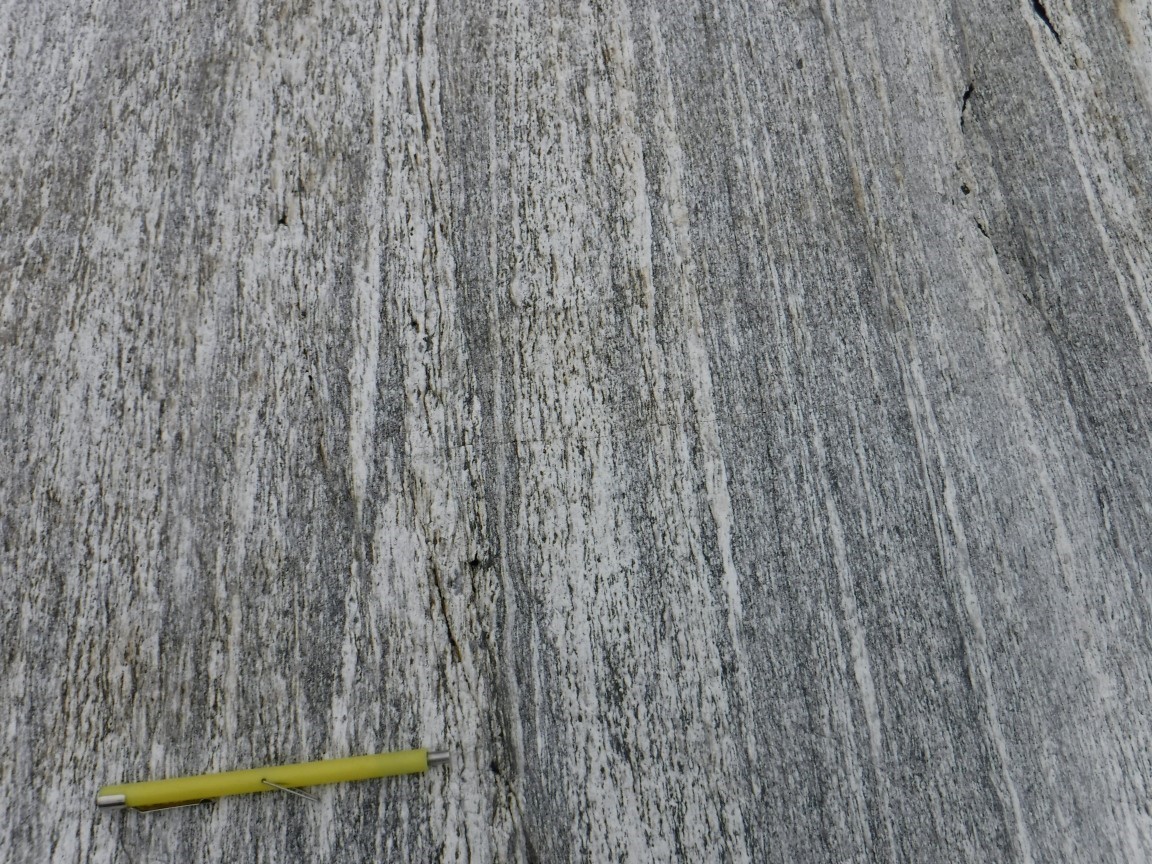 Layers of anorthositic composition have been reported by Verpaelst et al. (2000). This subunit is difficult to distinguish from the tonalitic to intermediate orthopyroxene gneiss of the Sukaliuk Complex due to the identical beige patina and olive-green hue; therefore, it is likely underrepresented following the mapping work of Mathieu et al. (2018). Rocks in this subunit exhibit centimetre- to decimetre-sized compositional banding. Plagioclase is very fine to fine grained and granoblastic. Quartz forms stretched lenses or rods. Ferromagnesian minerals (5 to 10%) are grouped in millimetric, flattened and stretched clusters composed of orthopyroxene, clinopyroxene, hornblende and red biotite. The accessory phases are sphene, apatite and opaque minerals. This subunit also includes a small amount of granoblastic gabbronorite in centimetric bands.
Layers of anorthositic composition have been reported by Verpaelst et al. (2000). This subunit is difficult to distinguish from the tonalitic to intermediate orthopyroxene gneiss of the Sukaliuk Complex due to the identical beige patina and olive-green hue; therefore, it is likely underrepresented following the mapping work of Mathieu et al. (2018). Rocks in this subunit exhibit centimetre- to decimetre-sized compositional banding. Plagioclase is very fine to fine grained and granoblastic. Quartz forms stretched lenses or rods. Ferromagnesian minerals (5 to 10%) are grouped in millimetric, flattened and stretched clusters composed of orthopyroxene, clinopyroxene, hornblende and red biotite. The accessory phases are sphene, apatite and opaque minerals. This subunit also includes a small amount of granoblastic gabbronorite in centimetric bands.
Thickness and Distribution
Rocks of the Nuvulialuk Suite typically are <1 km wide by 1-5 km long. The largest intrusions are in the areas of Mount Nuvulialuk (sheet 24I06) and Ijurvik Lake (sheet 24I03) where they are 2-3 km wide and nearly 20 km long. The Nuvulialuk Suite covers a limited area of ~360 km² and is uniformly distributed within the Falcoz Lithotectonic Domain. Rocks of the pPnuv1, pPnuv1a, and pPnuv1b units and subunits are the dominant lithologies, covering ~104 km², ~114 km², and ~86 km² respectively. The pPnuv2, pPnuv2a, and pPnuv3 units and subunits cover smaller areas, ~42 km², ~10 km², and ~4 km² respectively.
Dating
The age of ~1863 Ma was obtained in a decametric layer of amphibolite within a tonalitic orthogneiss of the Kangiqsualujjuaq Complex. The amphibolite is foliated and displays a lower degree of deformation than the gneiss with which it is intestratified. Verpaelst et al. (2000) interpret this amphibolite layer as a dyke of the Nuvulialuk Suite that was probably tectonically juxtaposed to the gneiss during the Paleoproterozoic deformation episode. The Archean age is interpreted as an inherited age of zircons that underwent remobilization during Trans-Hudsonian metamorphism.
The Geological Survey of Canada has dated the emplacement of a mafic intrusion associated with the Nuvulialuk Suite at ~1840 Ma. The sample was taken from the NE portion of sheet 24H10.
Charette et al. (2021) interpret a crystallization age of a garnet gneissic gabbronorite of the Nuvulialuk Suite around 1856 Ma (oldest zircon population). The sample analyzed was from an outcrop that was reassigned to the Nuvulialuk Suite by Lafrance and Vanier (2022). Charette et al. (2021) also dated the regression to the solidus phase at ~1817 Ma from the younger zircon population. Finally, Lu-Hf and Sm-Nd geochronological studies on garnets by these authors allowed them to interpret respectively the minimum crystallization age of this mineral (~1839 Ma) and the cooling age at the amphibolite facies (~1806 Ma).
| Unit | Sample | Isotopic System | Mineral | Crystallization Age (Ma) | (+) | (-) | Inherited Age (Ma) | (+) | (-) | Metamorphic Age (Ma) | (+) | (-) | Reference(s) |
| pPnuv1 | 14CXA-D27 | U-Pb | Zircon | 1840 | 14 | 14 | Pedreira Pérez, 2017 | ||||||
| 1998-DB-3099B | U-Pb | Zircon | 1863.1 | 6.5 | 6.5 | 2498.3 | 12 | 12 | David et al., 2009 | ||||
| pPnuv1b | 2013-BC-6117A | U-Pb | Zircon | 1856 | 5 | 5 | 1817 | 6 | 6 | Charette et al., 2021 | |||
| Lu-Hf | Garnet | 1839 | 5 | 5 | |||||||||
| Sm-Nd | 1806 | 26 | 26 |
Stratigraphic Relationship(s)
Ultramafic and mafic intrusive rocks of the Nuvulialuk Suite are commonly spatially associated with metasedimentary rocks of the Lake Harbour Suite. The contacts with the paragneiss and quartzite are marked by significant alteration indicating fluid circulation. Verpaelst et al. (2000) interpret these intrusive rocks as sills and dykes a few kilometres long that have developed within the Lake Harbour Suite volcano-sedimentary sequences. They also form imbricate layers within Archean gneissic complexes.
The work of Pedreira Pérez (2017) suggests that some of the intrusions assigned to the Nuvulialuk Suite, located near the ZCblm, correspond to an ophiolitic sequence. However, the work of Charette (2016) indicates that metasedimentary rocks from the area began to melt as of 1885 Ma (start of compressive regime and burial). The emplacement ages of 1840 Ma and 1863 Ma obtained in the Nuvulialuk Suite therefore seems to exclude the possibility that it is an ophiolite but rather differentiated intrusions.
Paleontology
Does not apply.
References
Publications available through SIGÉOM Examine
DAVID, J., MAURICE, C., SIMARD, M., 2009. DATATIONS ISOTOPIQUES EFFECTUÉES DANS LE NORD-EST DE LA PROVINCE DU SUPÉRIEUR – TRAVAUX DE 1998, 1999 ET 2000. MRNF; DV 2008-05, 92 pages.
LAFRANCE, I., BANDYAYERA, D., BILODEAU, C., 2015. GÉOLOGIE DE LA RÉGION DU LAC HENRIETTA (SNRC 24H). MERN; RG 2015-01, 62 pages, 1 plan.
LAFRANCE, I., BANDYAYERA, D., CHARETTE, B., BILODEAU, C., DAVID, J., 2016. GÉOLOGIE DE LA RÉGION DU LAC BRISSON (SNRC 24A). MERN; RG 2015-05, 64 pages, 1 plan.
LAFRANCE, I., CHARETTE, B., VANIER, M.-A., 2018. Sud-est de la Province de Churchill, Nunavik, Québec, Canada: synthèse de la géologie. MERN; BG 2018-12
LAFRANCE, I., VANIER, M.-A., 2022. Domaine lithotectonique de Falcoz, sud-est de la Province de Churchill, Nunavik, Québec, Canada : synthèse de la géologie. MERN; BG 2022-01, 2 plans.
MATHIEU, G., LAFRANCE, I., VANIER, M.-A., 2018. Géologie de la région de pointe Le Droit, Province de Nain et sud-est de la Province de Churchill, Nunavik, Québec, Canada. MERN; BG 2018-07, 4 plans.
VERPAELST, P., BRISEBOIS, D., PERREAULT, S., SHARMA, K. N. M., DAVID, J., 2000. Géologie de la région de la rivière Koroc et d’une partie de la région de Hébron, 24I et 14L. MRN; RG 99-08, 62 pages, 10 plans.
Other publications
CHARETTE, B., 2016. Long-lived Anatexis in the Exhumed Middle Crust from the Torngat Orogen and Eastern Core Zone: Constraints from Geochronology, Petrochronology, and Phase Equilibria Modeling. University of Waterloo; thèse de maîtrise, 389 pages. uwspace.uwaterloo.ca/handle/10012/10453
CHARETTE, B., GODET, A., GUILMETTE, C., DAVIS, D.W., VERVOORT, J., KENDALL, B., LAFRANCE, I., BANDYAYERA, D., YAKYMCHUK, C., 2021. Long-lived anatexis in the exhumed middle crust of the Torngat Orogen: Constraints from phase equilibria modeling and garnet, zircon, and monazite geochronology. Lithos, volume 388-389. doi.org/10.1016/j.lithos.2021.106022
PEDREIRA PÉREZ, R., 2017. La Suite mafique-ultramafique de Nuvulialuk : une nouvelle séquence ophiolitique dans l’arrière-pays de la Zone noyau du sud-est de la Province de Churchill (Québec). Université du Québec à Chicoutimi; mémoire de maîtrise, 170 pages. constellation.uqac.ca/4429/1/PedreiraPxE9rez_uqac_0862N_10387.pdf
Suggested Citation
Ministère de l’Énergie et des Ressources naturelles (MERN). Nuvulialuk Suite. Quebec Stratigraphic Lexicon. https://gq.mines.gouv.qc.ca/lexique-stratigraphique/province-de-churchill/suite-de-nuvulialuk_en [accessed on day month year].
Contributors
|
First publication |
Isabelle Lafrance, P.Geo., M.Sc. isabelle.lafrance@mern.gouv.qc.ca (redaction) Mehdi A. Guemache, P.Geo., Ph.D. (coordination); Claude Dion, Eng., M.Sc. (critical review); Simon Auclair, P.Geo., M.Sc. (editing); Céline Dupuis, P.Geo., Ph.D. (English version); Caroline Thorn (HTML editing) |
|||
|
Revision(s) |
Isabelle Lafrance, P.Geo., M.Sc. (redaction) Céline Dupuis, P.Geo., Ph.D. (coordination); Marc-Antoine Vanier, Eng., M.Sc. (critical review); Simon Auclair, P.Geo., M.Sc. (editing); Dominique Richard, GIT, Ph.D. (English version); André Tremblay (HTML editing) |
|||


